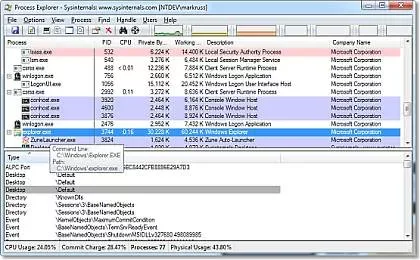Process Explorer poster process information that have opened or loaded descriptors and DLLs.
Two sub-windows make up the software display. The information displayed in the lower window depends on the mode the application is in: if it is in handle mode, you will see the handles opened by the selected process in the upper window; if it is in DLL mode, you will see the DLLs and memory-mapped files that the process selected in the top window has opened; if it is in DLL mode, you will see the DLLs and memory-mapped files that the process selected in the top window has opened. Process Explorer offers also a search function robust that allows you to quickly see which processes have specific handles open or DLLs loaded.
ProcessExplorer's unique features make it invaluable for locating DLL version issues, troubleshooting leaks, and better understanding how Windows and applications work.
What happened to Process Explorer?
PE is not included with Windows 10 or any other Microsoft operating system. The software must be downloaded from the Internet. You can extract the file to any location after downloading it.
After extracting the program, you will need to start the appropriate application for your machine. After Windows 98, the manager works on any Windows operating system, including Vista. Unless you choose to replace Task Manager with this one, you will need to run it from this file.
If you want to replace TM, all you have to do is press alt-ctrl-delete at the same time. In the new window that appears, select Task Manager. PE will work instead of TM by default.
What is Process Explorer and how can I use it?
You will see a very fancy user interface once Process Explorer has been downloaded and installed. It's not intuitive, but learning to use it successfully doesn't require a steep learning curve. Processes are the first thing to consider.
Running critical system programs are shown in red. The rest is shown in blue. Green represents CPU, yellow represents system commits, and orange-red represents RAM or physical memory.
Live time graphs to the right of the tabs correlate with CPU, commits, and RAM. This section also shows I/O and GPU status. A circle with outward arrows on the left helps you locate the running process.
What functions does it have?
You can also see the binoculars, which allow you to locate any program's handle or DLL. This feature allows you to locate problematic files and even track down suspected viruses.
This tab contains additional functionality such as properties, process trees, etc. Another important tool to highlight is the one found under the options. Virus Total can be found here, and it lets you search for apps that may be viruses.
If you choose it, you will be taken to a website where you will need to grant it permissions. Then it will compare all active processes to the most recent virus compilation accessible on the website, which is regularly updated by Google and other developers.
Process Explorer will display a count under the Total Viruses tab. If the number exceeds two, the software is almost certainly a virus. PE also shows the company that created the software as well as what it does in your system.
Should I use Process Explorer instead of Task Manager?
There are a few key distinctions between these two competitors. Due to its comprehensive functionality, PE has a significant advantage over Task Manager. It can even be used as an antivirus program or to show you exactly what a program is doing.
It's much easier to notice what's going on with your system once you get used to PE's interface. Compared to Task Manager's text-based approach, color coding and live graphical feed provide a faster and easier visual display.
What other task managers do you know?
Process Hacker is another solution for people who want to manipulate the process on their systems. This alternative is similar to PE, except it focuses more on debugging. You can also change the color scheme.
It falls short of Sysinternals because it has no antivirus function and is much more difficult to use. People familiar with technical jargon will be able to use this software for purposes other than PE.
Process Monitor is another Sysinternals tool for Windows. PM provides more details about the running process registry. It also allows you to observe the file system and its exact effects on your system. It can work in conjunction with Explorer.
Recognize even the simplest details
Overall, Process Explorer is a positive experience. It's a powerful tool that can help you identify and fix problems. It's simple to love the design. It will help you more than Task Manager, despite its unattractive appearance.
The process view and a shared validation column were added in the latest release. It also fixed a flaw that prevented the software from starting and running when the PC was put on battery power. Finally, a problem has been solved in the graphics system of the processor.
For more information, visit the Official website from Process Explorer.

